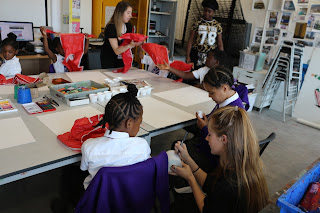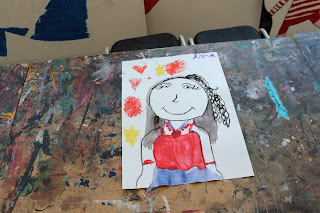Final Project Evaluation
The title of our community project was "Drawn Together" and we were assigned Crescent Primary School as a community partner, which is the primary school next to our school. We were put into a group of 12 with our classmates and we gave ourselves defined roles in the group under the categories of: Team Leader (2), Communications officers (4), Photographers(3) and Technicians (3). We decided these roles on the very first day which kept our group organised for the project, as we each knew what we had to do as the project progressed. We worked with 8 students aged 7-9 and held two workshops with them. Our workshops were skills based and revolved around the theme of culture which we derived from the school's art week theme of British values. The first workshop was held during the art week which meant we could directly tie in the work we were doing with them with what they were doing at school. In addition to our workshops we also had two meetings with Year 4 teacher Matthew Lamptey to exchange ideas, answer questions and propose what we were planning to do in collaboration with the school.
I think that the workshops were really good as the children really enjoyed both of them and got the chance to draw and paint freely which many of them said they don't really get a chance to do at home, as their parents don't want too much mess to be made. As well as this, they learnt more about what the word culture meant which was important for us to get across in our activities, as often the topic of British values can get a bit stereotypical and exclusionary. We also managed to the teach them the skill of mono printing which is a good basis for many other types of printing, and they really enjoyed trying out a new technique. I think we managed to match our proposal as our philosophy stayed the same throughout the project even when we were held back by things such as train strikes. We allowed the children to express their creativity and explore more than they would usually within art, something that we might be able to do as older students but is often shut away from younger students, even though childhood is a very important time to be able to express yourself and learn about the world.
The teachers who worked with us on the project (Matthew Lamptey and Trisha Brown) also really enjoyed the project. Matthew said he was happy to see the children experimenting with art and seeing students that he wouldn't have expected to create nice pieces create quite ambitious pieces that filled the page. Trisha Brown was really impressed with the work we did with the students and said that she was interested in using our teaching techniques in her own lessons. She was also very impressed by how well behaved the children were and how engaged they were. This was very good as it meant that our community partners were really happy with the project we did and thought it was successful. Between our workshops and giving the students the tapestry we made from their work I think we carried out a sustainable project that can be remembered by the school and replicated in the future.
To improve the project, we could have done more workshop activities with the students to expand their skillset within art even more, using some of the initial ideas we didn't use before such as creating the stencil or using recyclable materials. A lot of our group was gone at different times in the projects due to summer schools so if we were to redo we'd make sure all of our group could be in for the workshops. We could also make our activities a bit more structured so that the children would be able to see a clear progression.














































